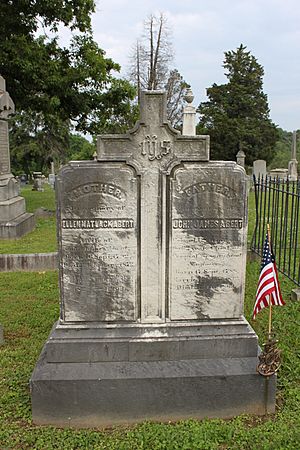John James Abert facts for kids
Quick facts for kids
John J. Abert
|
|
|---|---|

Portrait of Colonel John J. Abert
|
|
| Born | September 17, 1788 Shepherdstown, Virginia (now West Virginia) |
| Died | January 27, 1863 (aged 74) Washington, District of Columbia, U.S. |
| Buried |
Rock Creek Cemetery
Washington, D.C., U.S. |
| Allegiance | |
| Service/ |
|
| Years of service | 1814–1861 |
| Rank | |
| Commands held | Corps of Topographical Engineers |
| Alma mater | West Point |
| Spouse(s) | Ellen Matlack Stretch |
John James Abert (born September 17, 1788 – died January 27, 1863) was an important United States soldier. He led the Corps of Topographical Engineers for 32 years. During this time, he organized the mapping of the American West. His work helped explore and understand vast new areas of the country.
Contents
Early Life and Military Start
John J. Abert was born in Shepherdstown, which was then part of Virginia. He went to West Point, a famous military school, and graduated in 1811. However, he chose not to join the army right away. Instead, he decided to become a lawyer.
In January 1812, he married Ellen Matlack Stretch. When the War of 1812 began, Abert joined the D.C. Militia as a private. He bravely defended Washington in 1814. For his courage at the Battle of Bladensburg, he was given the honorary rank of brevet Major. In October 1814, he rejoined the army as a topographical engineer.
Leading the Topographical Engineers
In 1818, the U.S. War Department created the Topographic Bureau. This group was part of the Corps of Engineers. Its job was to collect and store maps and reports about the land. When the head of the Bureau died in 1829, John Abert took over.
Abert wanted the topographical engineers to be a separate group. He believed they could do more important work if they were not under the United States Army Corps of Engineers. In 1831, he convinced Congress to make them a separate corps. This new group reported directly to the United States Secretary of War.
Mapping the American West
In 1838, Abert was put in charge of the new Corps of Topographical Engineers. He led this group for 23 years. The Corps grew to include many officers and engineers. Abert made sure to hire the best soldier-scientists he could find. These included famous explorers like John C. Frémont, William H. Emory, and Andrew A. Humphreys.
These officers explored and mapped the lands west of the Mississippi River. Their work was very important for understanding and settling the American West.
A Lasting Legacy
Abert was a member of many important groups. These included legal, geographical, and scientific societies. He was also a member of the American Philosophical Society and the American Academy of Arts and Sciences. He retired from the Army in September 1861.
John J. Abert died in Washington, D.C., in 1863. He was buried in Rock Creek Cemetery. After he passed away, the U.S. War Department praised his work. They said his Corps had collected valuable information about the continent. This information was admired by scientists around the world. His work helped nearly every state and territory.
Abert's name lives on in several places and animals. Lake Albert in South Dakota is named after him. Captain John C. Frémont also named Lake Abert and Abert Rim in Oregon in his honor. The Abert's squirrel and Abert's towhee (a type of bird) were also named after him.
His Children
John J. Abert had several children who also achieved notable things:
- James William Abert (1820–1897): He was a soldier, explorer, and artist. He also became a topographical engineer.
- Silvanus Thayer Abert (1828–1903): He became a civil engineer.
- William Stretch Abert (1836–1867): He was a soldier.


